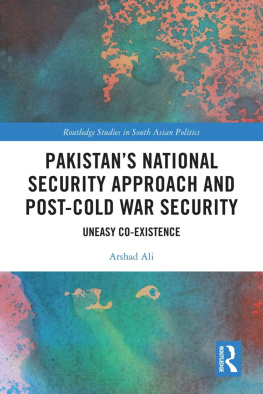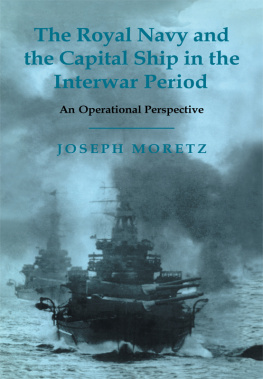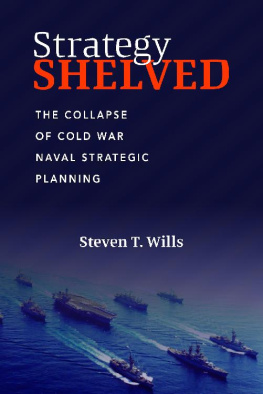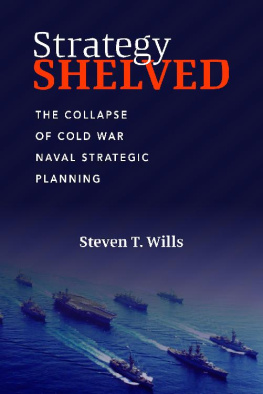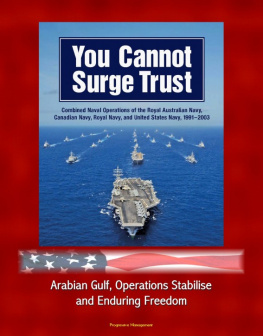Stanford University Press
Stanford, California
Editorial and design work
2009 by the Board of Trustees of the Leland Stanford Junior University
All rights reserved.
No part of this printing may be reproduced or transmitted in any form or by any means, electronic or mechanical, including photocopying and recording, or in any information storage or retrieval system without the prior written permission of Stanford University Press.
Printed in the United States of America on acid-free, archival-quality paper
Library of Congress Cataloging-in-Publication Data
Barlow, Jeffrey G.
From hot war to cold : The U.S. Navy and national security affairs, 19451955 / Jeffrey G. Barlow
p. cm.
Includes bibliographical references and index.
9780804770965
1. United States. NavyHistory20th century. 2. National securityUnited StatesHistory20th century. 3. United StatesMilitary policyDecision making. 4. Interservice rivalry (Armed Forces)United StatesHistory. 5. Sea-powerUnited StatesHistory20th century. 6. United StatesHistory, Naval20th century. I. Title.
VA58.B37 2009
359.03097309044dc22
2008022444
Designed and typeset at Stanford University Press in 10/12.5 Minion
Acknowledgments
During my years of working on this detailed study, I received help from a great many individuals and organizations. I first want to acknowledge the career officers who agreed to be interviewed about aspects of their military service: the late Captain Edward L. Beach, USN (Ret.), the late Admiral Walter F. Boone, USN (Ret.), the late Admiral Arleigh A. Burke, USN (Ret.), the late Admiral Robert B. Carney, USN (Ret.), the late Rear Admiral Thomas D. Davies, USN (Ret.), the late Admiral Robert L. Dennison, USN (Ret.), the late General Andrew J. Goodpaster, USA (Ret.), Vice Admiral Howard E. Greer, USN (Ret.), the late Admiral Charles D. Griffin, USN (Ret.), the late General Lyman L. Lemnitzer, USA (Ret.), the late Captain Frank A. Manson, USN (Ret.), Vice Admiral Gerald E. Miller, USN (Ret.), Captain Robert A. Rowe, USN (Ret.), the late Brigadier General Samuel R. Shaw, USMC (Ret.), and Lieutenant General Woodrow W. Vaughn, USA (Ret.). I also am very grateful to Hugh L. Hanson, who served for many years as one of the Navys premier aeronautical engineers, for providing me with original documents and copies of other material related to the Navys fight to maintain the status of naval aviation during the late 1940s.
While conducting documentary research for this book, I have had the generous assistance of a substantial number of archivists and librarians around the United States. Those who deserve particular thanks are: James Leyerzapf and David Haight of the Dwight D. Eisenhower Library in Abilene, Kansas; Bob Clark and the other archivists of the Franklin D. Roosevelt Library in Hyde Park, New York; Dennis Bilger of the Harry S. Truman Library in Independence, Missouri; James Hutson and the rest of the staff of the Library of Congresss Manuscript Division; John Taylor and the present and former archivists of the National Archives and Records Administration facilities in Washington, D.C., and College Park, Maryland, including Richard von Doehnhoff, Barry Zerbe, Sandy Smith, Wilbert Mahoney, Richard Boylan, Dr. Cary Conn, Dr. Timothy Nenninger, and Richard Myers; Velecia Chance and Michael Waesche of the Reference Service Branch of the Washington National Records Center in Suitland, Maryland; the present and former historians of the Air Force Historical Studies Office now located at Anacostia Naval Annex, Washington, D.C., especially Herman Wolk, Dr. George M. Watson, Jr., Dr. Roger G. Miller, Dr. Walton S. Moody, and Sheldon Goldberg; former archivist Fred J. Graboske of the Marine Corps Historical Center, and Dr. Leo J. Daugherty, III (Gunnery Sergeant, U.S. Marine Corps Reserve) and the other volunteers who were working with the Centers Personal Papers Collection at the Washington Navy Yard, D.C. (now redesignated the Marine Corps History Division and located at Marine Corps Base Quantico, Virginia); Dr. Elaine M. Cherpak, the archivist of the Naval Historical Collection, U.S. Naval War College, Newport, Rhode Island; Mary Marshall Clark and Rosemary Newnham, the Director and Assistant Director of Columbia Universitys Oral History Research Office, and Dr. Ronald Grele, Director Emeritus; Nancy Bressler of the Seeley G. Mudd Manuscript Library, Princeton University; the staff of the George C. Marshall Research Library in Lexington, Virginia; Dr. Richard J. Sommers and David A. Keough of the U.S. Army Military History Institute in Carlisle, Pennsylvania; archivist James W. Zoebel of the MacArthur Memorial Library and Archives in Norfolk, Virginia; and the staff of the Archives of the Hoover Institution on War, Revolution and Peace at Stanford University.
During the past decade and a half I also have had the privilege of attending many of the events sponsored at the Woodrow Wilson Center in Washington, D.C., by the Cold War International History Project and of receiving its published Bulletins and Working Papers. Our historical knowledge of the Cold War as seen from the perspectives of the leaders of the Soviet Union, China, and the countries of Eastern Europe has been immeasurably advanced by the ongoing activities of the Project and its contributing scholars. And indeed, my own understanding of various aspects of the early Cold War is much the richer because of the Cold War International History Projects efforts.
Over the many years it took for this manuscript to be completed, my present and former colleagues in the Contemporary History Branch contributed to the effort in a variety of ways. These co-workers include Robert J. Cressman, Dr. Lynne K. Dunn, Dr. Mark H. Jacobsen, Dr. Theresa L. Kraus, Dr. Michael A. Palmer, Dr. Randy Papadopoulos, Richard A. Russell, Dr. Robert J. Schneller, Jr., Dr. John D. Sherwood, and Dr. Clarence E. Wunderlin, Jr. My former Branch Head, Dr. Edward J. Marolda, now Head of the Centers Histories & Archives Division, and my present Branch Head, Dr. Gary E. Weir, were highly supportive during the research and writing effort.
Sandra J. Doyle, the Centers Senior Editor, did her usual thorough job in giving the manuscript an initial edit. Ella W. Nargele successfully maneuvered the completed manuscript through the required security and policy review process in seemingly record time. I also wish to thank Chief Daniel Springston, a Navy Reservist who worked on records declassification at the Center in the late 1990s, for bringing to my attention several important, newly declassified transcripts from Admiral Arleigh A. Burkes personal official papers.
I am also extremely grateful to those Naval Historical Center colleagues who provided expert archival and bibliographic help during the research and writing process. In the Centers Operational Archives, Bernard F. Cavalcante and Kathleen M. Lloyd, the former and current Branch Heads, and their reference archivists over the years, including Dr. Regina T. Akers, Kenneth Johnson, George W. Pryce, III and Richard M. Walker, provided tremendous assistance in locating potentially valuable documentary materials. In the Centers Navy Department Library, its successive Directors John E. Vadja, Jean L. Hort, and Glenn E. Helm, and their staff members, including David Brown, Davis Elliott, and Tonya Simpson, directed me to appropriate sources or supplied needed books obtained through interlibrary loan.


